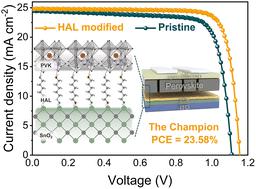当前位置:
X-MOL 学术
›
Inorg. Chem. Front.
›
论文详情
Our official English website, www.x-mol.net, welcomes your
feedback! (Note: you will need to create a separate account there.)
Enhanced performance of perovskite solar cells via a bilateral electron-donating passivator as a molecule bridge
Inorganic Chemistry Frontiers ( IF 6.1 ) Pub Date : 2023-08-29 , DOI: 10.1039/d3qi01531a Weichun Pan 1 , Pengxu Chen 1 , Sijia Zhu 1 , Ruowei He 1 , Qingshui Zheng 1 , Fengxian Cao 1 , Zhang Lan 1 , Jihuai Wu 1 , Weihai Sun 1 , Yunlong Li 2
Inorganic Chemistry Frontiers ( IF 6.1 ) Pub Date : 2023-08-29 , DOI: 10.1039/d3qi01531a Weichun Pan 1 , Pengxu Chen 1 , Sijia Zhu 1 , Ruowei He 1 , Qingshui Zheng 1 , Fengxian Cao 1 , Zhang Lan 1 , Jihuai Wu 1 , Weihai Sun 1 , Yunlong Li 2
Affiliation

|
Defects at the buried interface are the primary factors contributing to recombination losses and instability in perovskite solar cells (PSCs) with n–i–p structure. Here, a molecule with bilateral electron-donating groups, 6-amino-1-hexanol (HAL), is introduced between SnO2 and perovskite (PVK) to optimize the characteristics of the buried interfacial properties, as well as the PVK film quality. The surface defects of SnO2 can be more effectively passivated, and its energy level structure can be tuned more appropriately. Meanwhile, the electron-donating groups in HAL can passivate the Pb2+ defects and stabilize the [PbI6]4− octahedra at the buried interface. With the assistance of bilateral electron-donating groups, HAL can act as a molecular bridge to easily bridge SnO2 and PVK to passivate the buried interfacial defects, thus enhancing device performance. As a result, the photovoltaic performance was significantly improved by the buried modification with HAL, ultimately achieving a champion PCE of 23.58%, far superior to the inferior PCE of 21.30% of the pristine device. Furthermore, after 35 days of storage at approximately 35% relative humidity (RH) and room temperature, the device based on HAL-modified SnO2 demonstrates significantly better stability than the pristine device, as it still maintains over 90% of the initial efficiency. This study provides an effective molecular bridge strategy for further enhancing the performance of PSCs.
中文翻译:

通过双边供电子钝化剂作为分子桥增强钙钛矿太阳能电池的性能
埋入界面的缺陷是导致 n-i-p 结构钙钛矿太阳能电池(PSC)复合损失和不稳定的主要因素。在此,在SnO 2和钙钛矿(PVK )之间引入具有双边给电子基团的分子6-氨基-1-己醇(HAL),以优化埋入界面特性以及PVK薄膜质量。可以更有效地钝化SnO 2的表面缺陷,并且可以更适当地调节其能级结构。同时,HAL中的给电子基团可以钝化Pb 2+缺陷并稳定[PbI 6 ] 4−埋入界面处呈八面体。在双边给电子基团的帮助下,HAL可以作为分子桥,轻松桥接SnO 2和PVK,钝化掩埋的界面缺陷,从而提高器件性能。结果,通过HAL掩埋改性,光伏性能显着提高,最终实现了23.58%的冠军PCE,远远优于原始器件21.30%的劣势PCE。此外,在约 35% 相对湿度 (RH) 和室温下储存 35 天后,基于 HAL 改性 SnO 2的器件与原始设备相比,它表现出明显更好的稳定性,因为它仍然保持着超过 90% 的初始效率。该研究为进一步提高PSC的性能提供了有效的分子桥策略。
更新日期:2023-08-29
中文翻译:

通过双边供电子钝化剂作为分子桥增强钙钛矿太阳能电池的性能
埋入界面的缺陷是导致 n-i-p 结构钙钛矿太阳能电池(PSC)复合损失和不稳定的主要因素。在此,在SnO 2和钙钛矿(PVK )之间引入具有双边给电子基团的分子6-氨基-1-己醇(HAL),以优化埋入界面特性以及PVK薄膜质量。可以更有效地钝化SnO 2的表面缺陷,并且可以更适当地调节其能级结构。同时,HAL中的给电子基团可以钝化Pb 2+缺陷并稳定[PbI 6 ] 4−埋入界面处呈八面体。在双边给电子基团的帮助下,HAL可以作为分子桥,轻松桥接SnO 2和PVK,钝化掩埋的界面缺陷,从而提高器件性能。结果,通过HAL掩埋改性,光伏性能显着提高,最终实现了23.58%的冠军PCE,远远优于原始器件21.30%的劣势PCE。此外,在约 35% 相对湿度 (RH) 和室温下储存 35 天后,基于 HAL 改性 SnO 2的器件与原始设备相比,它表现出明显更好的稳定性,因为它仍然保持着超过 90% 的初始效率。该研究为进一步提高PSC的性能提供了有效的分子桥策略。





















































 京公网安备 11010802027423号
京公网安备 11010802027423号